The “Potential threats detected” alert is a misleading adverising. It can be used to trick you into calling a fake Support service or reroute your web-browser to other malicious and misleading web-pages. If the Edge, Chrome, Mozilla Firefox and IE opens automatically to these “Potential threats detected” fake alerts, then it could mean that your personal computer has been hijacked with the obnoxious malicious software from the adware family. In most cases, this unwanted software installs on the PC system in a bundle with free applications that you downloaded and installed from the Web. Once it gets inside your computer, it will alter certain computer’s settings including search engine, home page and newtab page in order to redirect your’s web browser to ad pages or show a lot of undesired pop up advertisements from various third-party ad networks.
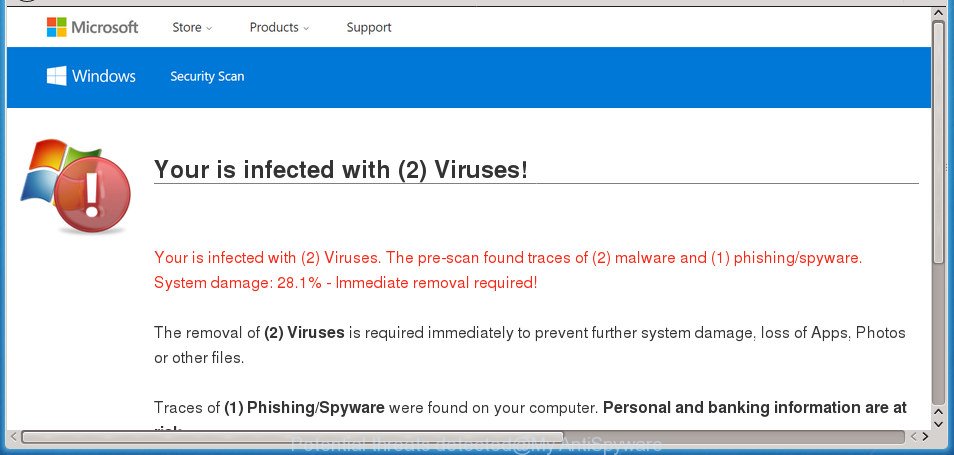
The “Potential threats detected” popup alert is a misleading advertising like shown on the example above
What is more, the ad-supported software that causes multiple misleading “Potential threats detected” alerts and popups, may show ads depend on a webpage that you are visiting. That is, it’s clear that this adware, without your permission, steals confidential data about you such as: your ip address, what is a site you are viewing now, what you are looking for on the Internet, which links you are clicking, and much, much more. The worst is, the adware may monetize its functionality by collecting confidential information from your surfing sessions. This confidential info, afterwards, can be easily sold to third parties. This puts your personal info at a security risk.
In addition to that, as was mentioned earlier, certain ad-supported software to also change all web-browsers shortcuts that located on your Desktop or Start menu. So, every infected shortcut will try to redirect your web-browser to annoying ad web-sites such as “Potential threats detected”, certain of which might be harmful. It can make the whole computer more vulnerable to hacker attacks.
Instructions that is shown below, will help you to clean your personal computer from the ‘ad supported’ software as well as remove “Potential threats detected” annoying pop-ups from the Firefox, Microsoft Internet Explorer, Google Chrome and MS Edge and other internet browsers.
How to remove “Potential threats detected” fake alerts
The following steps will help you to delete “Potential threats detected” pop-up warnings from the Chrome, Microsoft Edge, Microsoft Internet Explorer and Firefox. Moreover, the few simple steps below will help you to get rid of malicious software, browser hijacker infections, PUPs and toolbars that your computer may be infected. Please do the guide step by step. If you need help or have any questions, then ask for our assistance or type a comment below. Read this manual carefully, bookmark or print it, because you may need to close your browser or restart your PC system.
To remove “Potential threats detected”, execute the following steps:
- Remove “Potential threats detected” popup warnings without any tools
- Remove “Potential threats detected” associated software by using MS Windows Control Panel
- Disinfect the browser’s shortcuts to remove “Potential threats detected” redirect
- Delete unwanted Scheduled Tasks
- Delete “Potential threats detected” from Mozilla Firefox by resetting web-browser settings
- Remove “Potential threats detected” pop-up from Google Chrome
- Get rid of “Potential threats detected” pop up scam from Internet Explorer
- Use free malware removal tools to completely remove “Potential threats detected” fake alerts
- Block “Potential threats detected” pop-up warnings and other annoying webpages
- Method of “Potential threats detected” pop up scam intrusion into your PC system
- To sum up
Remove “Potential threats detected” popup warnings without any tools
The useful removal instructions for the “Potential threats detected” pop up scam. The detailed procedure can be followed by anyone as it really does take you step-by-step. If you follow this process to get rid of “Potential threats detected” fake alerts let us know how you managed by sending us your comments please.
Remove “Potential threats detected” associated software by using MS Windows Control Panel
First of all, check the list of installed applications on your machine and remove all unknown and recently installed apps. If you see an unknown application with incorrect spelling or varying capital letters, it have most likely been installed by malicious software and you should clean it off first with malware removal tool like Zemana Anti-malware.
Press Windows button ![]() , then press Search
, then press Search ![]() . Type “Control panel”and press Enter. If you using Windows XP or Windows 7, then click “Start” and select “Control Panel”. It will display the Windows Control Panel as shown on the screen below.
. Type “Control panel”and press Enter. If you using Windows XP or Windows 7, then click “Start” and select “Control Panel”. It will display the Windows Control Panel as shown on the screen below.

Further, press “Uninstall a program” ![]()
It will show a list of all software installed on your PC. Scroll through the all list, and uninstall any suspicious and unknown programs.
Disinfect the browser’s shortcuts to remove “Potential threats detected” redirect
After the ‘ad supported’ software is started, it can also alter the web browser’s shortcuts, adding an argument similar to “http://site.address” into the Target field. Due to this, every time you launch the web browser, it will show an intrusive webpage.
To clear the browser shortcut file, right-click to it and choose Properties. On the Shortcut tab, locate the Target field. Click inside, you will see a vertical line – arrow pointer, move it (using -> arrow key on your keyboard) to the right as possible. You will see a text like “http://site.address” which has been added here. You need to delete it.

When the text is removed, press the OK button. You need to clean all shortcuts of all your browsers, as they may be infected too.
Delete unwanted Scheduled Tasks
Once installed, the adware can add a task in to the Windows Task Scheduler Library. Due to this, every time when you boot your system, it will open “Potential threats detected” unwanted web page. So, you need to check the Task Scheduler Library and remove all harmful tasks that have been created by malicious applications.
Press Windows and R keys on the keyboard together. This opens a prompt that titled with Run. In the text field, type “taskschd.msc” (without the quotes) and press OK. Task Scheduler window opens. In the left-hand side, click “Task Scheduler Library”, as shown in the figure below.

Task scheduler
In the middle part you will see a list of installed tasks. Please choose the first task, its properties will be display just below automatically. Next, click the Actions tab. Pay attention to that it launches on your computer. Found something like “explorer.exe http://site.address” or “chrome.exe http://site.address”, then remove this harmful task. If you are not sure that executes the task, check it through a search engine. If it is a component of the ‘ad-supported’ program, then this task also should be removed.
Having defined the task that you want to remove, then press on it with the right mouse button and choose Delete as displayed in the following example.

Delete a task
Repeat this step, if you have found a few tasks which have been created by unwanted applications. Once is complete, close the Task Scheduler window.
Delete “Potential threats detected” from Mozilla Firefox by resetting web-browser settings
Resetting Firefox browser will reset all the settings to their default values and will remove “Potential threats detected” popup scam, malicious add-ons and extensions. Essential information like bookmarks, browsing history, passwords, cookies, auto-fill data and personal dictionaries will not be removed.
Launch the Firefox and press the menu button (it looks like three stacked lines) at the top right of the web-browser screen. Next, click the question-mark icon at the bottom of the drop-down menu. It will show the slide-out menu.

Select the “Troubleshooting information”. If you are unable to access the Help menu, then type “about:support” in your address bar and press Enter. It bring up the “Troubleshooting Information” page as displayed below.

Click the “Refresh Firefox” button at the top right of the Troubleshooting Information page. Select “Refresh Firefox” in the confirmation prompt. The Mozilla Firefox will begin a task to fix your problems that caused by the adware that causes web browsers to open misleading “Potential threats detected” popup warnings. After, it is done, press the “Finish” button.
Remove “Potential threats detected” pop-up from Google Chrome
Like other modern web-browsers, the Google Chrome has the ability to reset the settings to their default values and thereby restore the web-browser’s settings such as default search provider, homepage and newtab that have been replaced by the ad supported software which designed to show misleading “Potential threats detected” fake alerts within your web browser.
Open the Chrome menu by clicking on the button in the form of three horizontal dotes (![]() ). It will open the drop-down menu. Select More Tools, then press Extensions.
). It will open the drop-down menu. Select More Tools, then press Extensions.
Carefully browse through the list of installed extensions. If the list has the extension labeled with “Installed by enterprise policy” or “Installed by your administrator”, then complete the following guidance: Remove Chrome extensions installed by enterprise policy otherwise, just go to the step below.
Open the Google Chrome main menu again, click to “Settings” option.

Scroll down to the bottom of the page and click on the “Advanced” link. Now scroll down until the Reset settings section is visible, as shown on the screen below and click the “Reset settings to their original defaults” button.

Confirm your action, press the “Reset” button.
Get rid of “Potential threats detected” pop up scam from Internet Explorer
If you find that Internet Explorer web-browser settings like newtab, search engine by default and start page had been changed by adware that causes multiple misleading “Potential threats detected” alerts and popups, then you may restore your settings, via the reset internet browser procedure.
First, launch the IE, click ![]() ) button. Next, click “Internet Options” as displayed on the screen below.
) button. Next, click “Internet Options” as displayed on the screen below.

In the “Internet Options” screen select the Advanced tab. Next, press Reset button. The Internet Explorer will display the Reset Internet Explorer settings dialog box. Select the “Delete personal settings” check box and press Reset button.

You will now need to reboot your computer for the changes to take effect. It will get rid of adware that causes internet browsers to open misleading “Potential threats detected” pop-up warnings, disable malicious and ad-supported web browser’s extensions and restore the Microsoft Internet Explorer’s settings such as startpage, search engine and newtab to default state.
Use free malware removal tools to completely remove “Potential threats detected” fake alerts
If you are unsure how to delete “Potential threats detected” pop-up easily, consider using automatic ad-supported software removal software that listed below. It will identify the adware that designed to display misleading “Potential threats detected” popup warnings within your web-browser and get rid of it from your computer for free.
Scan and free your browser of “Potential threats detected” fake alerts with Zemana Anti-malware
Zemana Anti-malware highly recommended, because it can detect security threats such ad supported software and adwares that most ‘classic’ antivirus apps fail to pick up on. Moreover, if you have any “Potential threats detected” pop-up removal problems which cannot be fixed by this tool automatically, then Zemana Anti-malware provides 24X7 online assistance from the highly experienced support staff.

- Click the following link to download the latest version of Zemana for Windows. Save it directly to your MS Windows Desktop.
Zemana AntiMalware
164748 downloads
Author: Zemana Ltd
Category: Security tools
Update: July 16, 2019
- Once the downloading process is complete, close all software and windows on your personal computer. Open a file location. Double-click on the icon that’s named Zemana.AntiMalware.Setup.
- Further, click Next button and follow the prompts.
- Once install is done, click the “Scan” button . Zemana AntiMalware (ZAM) program will scan through the whole PC for the ad supported software that cause misleading “Potential threats detected” popup to appear. This task may take some time, so please be patient. While the Zemana Anti Malware (ZAM) program is scanning, you may see count of objects it has identified as threat.
- Once Zemana Free completes the scan, Zemana will open you the results. In order to remove all threats, simply click “Next”. When finished, you can be prompted to restart your PC.
Delete “Potential threats detected” popup scam and malicious extensions with HitmanPro
HitmanPro will help remove adware which displays misleading “Potential threats detected” pop-up scam on your machine that slow down your PC. The hijacker infections, adware and other PUPs slow your browser down and try to trick you into clicking on malicious advertisements and links. Hitman Pro removes the adware and lets you enjoy your PC without “Potential threats detected” pop up warnings.
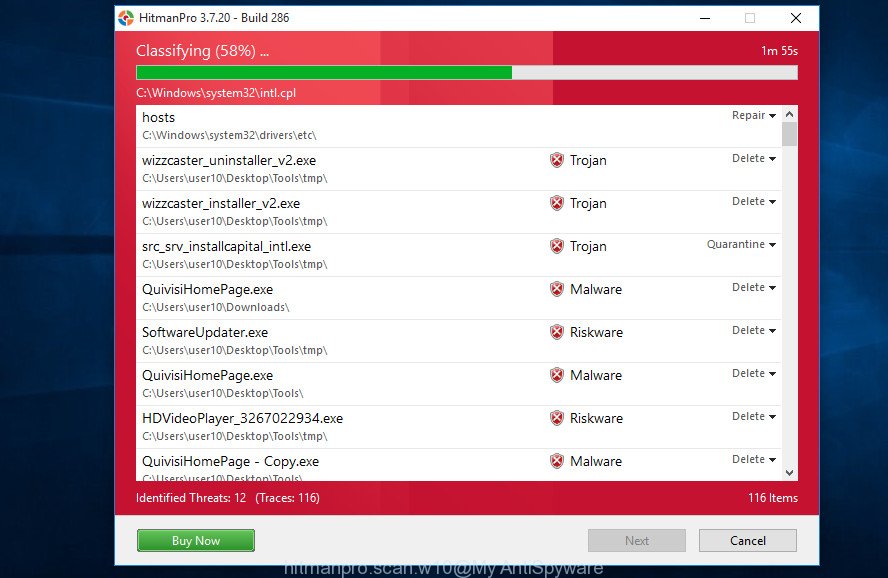
- HitmanPro can be downloaded from the following link. Save it on your Windows desktop.
- When the downloading process is finished, double click the HitmanPro icon. Once this utility is started, click “Next” button to perform a system scan for the adware that made to display misleading “Potential threats detected” fake alerts within your web-browser. This task can take some time, so please be patient. While the HitmanPro is checking, you can see how many objects it has identified either as being malware.
- Once finished, the results are displayed in the scan report. In order to get rid of all items, simply click “Next” button. Now press the “Activate free license” button to begin the free 30 days trial to delete all malicious software found.
Automatically get rid of “Potential threats detected” pop-up warnings with Malwarebytes
You can remove “Potential threats detected” fake alerts automatically with a help of Malwarebytes Free. We recommend this free malware removal tool because it can easily delete browser hijackers, ‘ad supported’ software, PUPs and toolbars with all their components such as files, folders and registry entries.
Please go to the link below to download the latest version of MalwareBytes Anti-Malware for Microsoft Windows. Save it to your Desktop so that you can access the file easily.
327016 downloads
Author: Malwarebytes
Category: Security tools
Update: April 15, 2020
Once the downloading process is done, close all software and windows on your computer. Double-click the setup file called mb3-setup. If the “User Account Control” dialog box pops up as on the image below, click the “Yes” button.
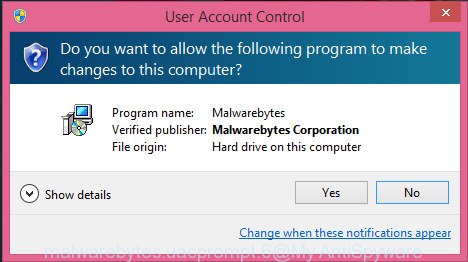
It will open the “Setup wizard” which will help you setup MalwareBytes Anti-Malware (MBAM) on your machine. Follow the prompts and don’t make any changes to default settings.
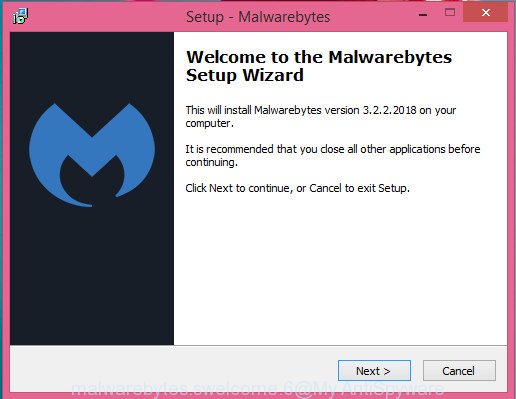
Once install is finished successfully, click Finish button. MalwareBytes Free will automatically start and you can see its main screen as displayed in the figure below.
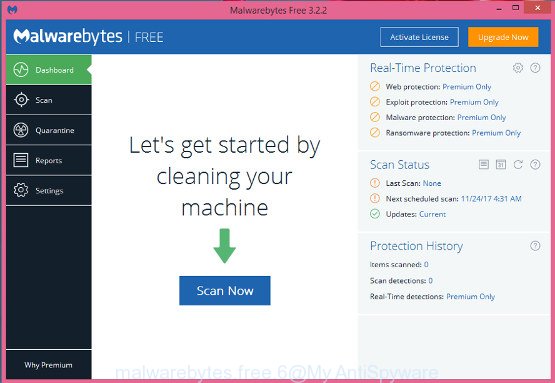
Now click the “Scan Now” button . MalwareBytes Free tool will start scanning the whole machine to find out adware that cause misleading “Potential threats detected” pop-up to appear. This task can take quite a while, so please be patient. When a malicious software, ad-supported software or PUPs are detected, the number of the security threats will change accordingly. Wait until the the scanning is done.
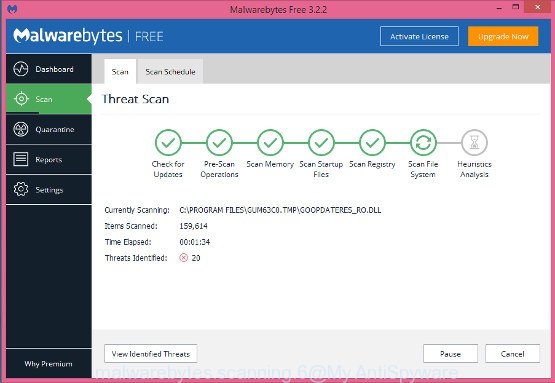
After the scan get completed, MalwareBytes Free will prepare a list of unwanted and adware. Once you’ve selected what you want to remove from your PC press “Quarantine Selected” button. The MalwareBytes Free will start to remove adware which causes misleading “Potential threats detected” popup on your browser. After the task is done, you may be prompted to restart the machine.
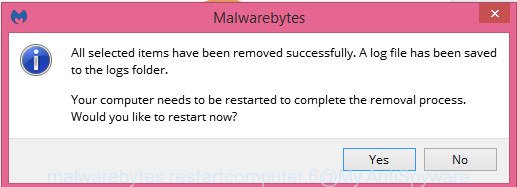
We suggest you look at the following video, which completely explains the process of using the MalwareBytes Anti-Malware (MBAM) to remove ‘ad supported’ software, browser hijacker infection and other malware.
Block “Potential threats detected” pop-up warnings and other annoying webpages
Enabling an ad-blocking application like AdGuard is an effective way to alleviate the risks. Additionally, ad blocking programs will also protect you from malicious advertisements and web pages, and, of course, stop redirection chain to “Potential threats detected” and similar pages.
- Visit the page linked below to download the latest version of AdGuard for Microsoft Windows. Save it on your Microsoft Windows desktop or in any other place.
Adguard download
26828 downloads
Version: 6.4
Author: © Adguard
Category: Security tools
Update: November 15, 2018
- After downloading it, launch the downloaded file. You will see the “Setup Wizard” program window. Follow the prompts.
- After the setup is finished, press “Skip” to close the install program and use the default settings, or click “Get Started” to see an quick tutorial that will help you get to know AdGuard better.
- In most cases, the default settings are enough and you do not need to change anything. Each time, when you run your machine, AdGuard will launch automatically and block advertisements, “Potential threats detected” scam, as well as other harmful or misleading webpages. For an overview of all the features of the application, or to change its settings you can simply double-click on the icon named AdGuard, which can be found on your desktop.
Method of “Potential threats detected” pop up scam intrusion into your PC system
Most commonly the adware come along with freeware. So, think back, have you ever download and run any free software? Because most users, in the Setup Wizard, simply click the Next button and do not read any information like ‘Terms of use’ and ‘Software license’. This leads to the fact that the PC system is infected and all your web browsers configured to show a large number of annoying “Potential threats detected” pop-ups. Even removing the free applications that contains this ad-supported software, the intrusive popup advertisements does not disappear. Therefore, you must follow the few simple steps above to clean your computer from the ad supported software and thereby delete “Potential threats detected” fake alerts.
To sum up
After completing the guide above, your computer should be clean from this ‘ad supported’ software and other malicious software. The Edge, Microsoft Internet Explorer, Chrome and Mozilla Firefox will no longer show intrusive “Potential threats detected” web site when you surf the Internet. Unfortunately, if the few simple steps does not help you, then you have caught a new adware, and then the best way – ask for help.
Please start a new thread by using the “New Topic” button in the Spyware Removal forum. When posting your HJT log, try to give us some details about your problems, so we can try to help you more accurately. Wait for one of our trained “Security Team” or Site Administrator to provide you with knowledgeable assistance tailored to your problem with the annoying “Potential threats detected” fake alerts.













 (Quick & Easy) in 2024
(Quick & Easy) in 2024






